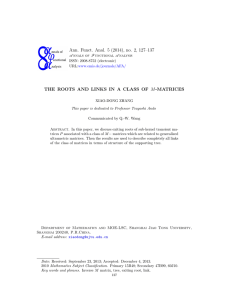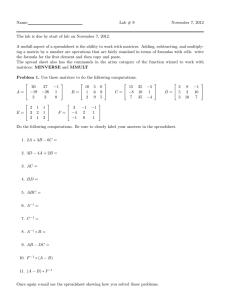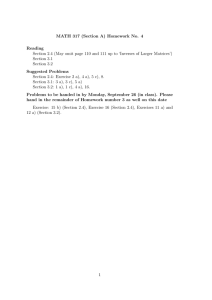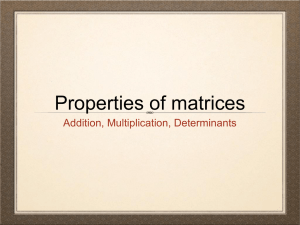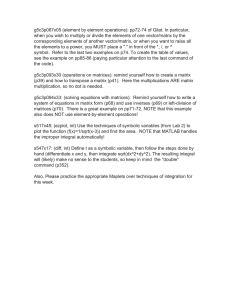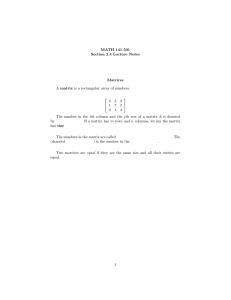Matrices (Laplace Transform work will continue on Monday)
advertisement
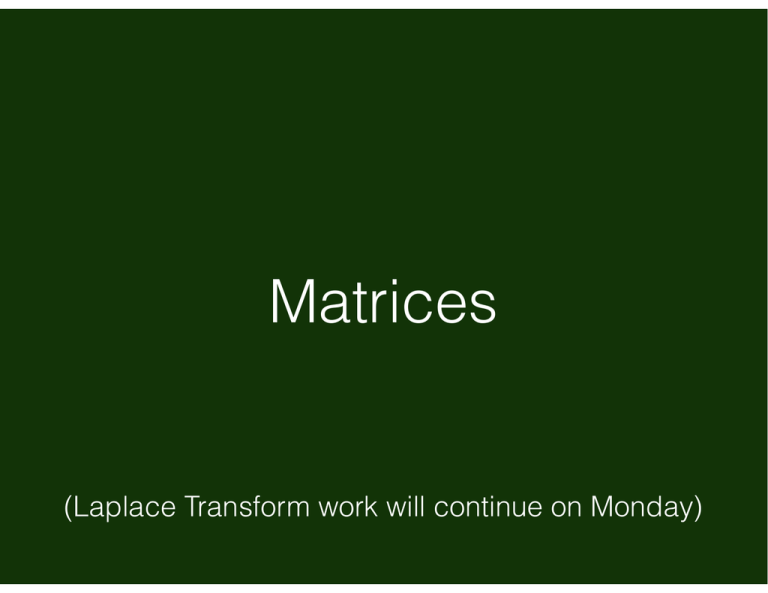
Matrices (Laplace Transform work will continue on Monday) Matrices Appendix II Matrices Part 1: Why we’ll care Appendix II Systems of Linear DiffEqs Systems of Linear DiffEqs 8 dx > = < dt > : dy dt 5x = 4x y y Systems of Linear DiffEqs 8 dx > = < dt > : dy dt 5x = 4x y y Why is this linear again? Systems of Linear DiffEqs 8 dx > = < dt > : dy dt 5x = 4x y y Only numbers multiplying x, y Systems of Linear DiffEqs 8 dx > = 3x + 4y < dt > : dy dt = 5x 7y Here’s another Systems of Linear DiffEqs 8 dx > = < dt > : dy dt 2x + 101y = 5.2x + y And… another Systems of Linear DiffEqs 8 dx > < dt = 3x + 4y > : dy dt = 5x 8 dx > < dt = 7y > : dy dt 8 dx > < dt = > : dy dt 2x + 101y 5x = 4x y y = 5.2x + y What info do we really need to describe each? Systems of Linear DiffEqs 8 dx > < dt =33x +44y > : dy dt 8 dx > < dt = –55x –1y y > : dy =55x –77y dt 8 dx > 101y y < dt = –22x + 101 > : dy dt = 5.2x y 1y 101x+ + The rest is always the same. =44x –1y y Systems of Linear DiffEqs 8 dx > < dt = 33x +44y > : dy dt =55x –77y Systems of Linear DiffEqs 8 dx > < dt = 33x +44y > : dy dt =55x –77y x y x y Systems of Linear DiffEqs 0 @ x y 1 A Systems of Linear DiffEqs 0 @ x y 1 A Systems of Linear DiffEqs 0 @ x y 1 A Systems of Linear DiffEqs 0 @ x y 1 A 3x + 4y Systems of Linear DiffEqs 0 @ x y 1 A 3x + 4y 5x + 7y Systems of Linear DiffEqs 0 @ xx yx 1 y A y Systems of Linear DiffEqs 8 dx > < dt = 33x +44y > : dy dt =55x –77y 0 @ dx dt dy dt 1 0 A= @ Matrix x y 1 A Systems of Linear DiffEqs 8 dx > < dt = 33x +44y > : dy dt =55x –77y 0 @ dx dt dy dt 1 0 A= @ Vectors x y 1 A Systems of Linear DiffEqs 8 dx > < dt = –55x –1y y > : dy dt =44x –1y y 0 @ dx dt dy dt 1 0 A=@ 5 4 1 1 10 A@ x y 1 A Systems of Linear DiffEqs 8 dx > 101y y < dt = –22x + 101 > : dy dt = 5.2x y 1y 101x++ 0 @ dx dt dy dt 1 0 A=@ 2 101 101 1 10 A@ x y 1 A Matrices Part 2: Multiplying Matrices Appendix II Multiplying Matrices? • 0 @ 5 4 1 1 1 A = ??? Multiplying Matrices • 0 @ 0 @ 5 1 4 x • y 1 1 A 1 A = ??? Multiplying Matrices • 0 @ 0 @ 5 1 4 x • y 1 1 1 A 0 A=@ = ??? 3x + 4y 5x + 7y 1 A Multiplying Matrices • 0 @ 0 @ 5 1 4 x • y 1 1 A 1 A 0 =@ 0 1 = @ 3x + 4y 5x + 7y A 1 A Multiplying Matrices • 0 @ 0 @ 5 1 4 x • y 1 1 1 A 0 A=@ 0 = @ 3x + 4y 5x + 7y 3x5 + 4x4 1 A 1 A Multiplying Matrices • 0 @ 0 @ 5 1 4 x • y 1 1 1 A 0 A=@ 0 = @ 3x + 4y 5x + 7y 31 1 A 1 A Multiplying Matrices • 0 @ 0 @ 5 1 4 x • y 1 1 1 A 0 A=@ 0 31 = @ ?? 3x + 4y 1 5x + 7y A 1 A Multiplying Matrices • 0 @ 0 @ 5 1 4 x • y 1 1 1 A 0 A=@ 0 = @ 3x + 4y 5x + 7y 31 1 A 1 A Multiplying Matrices • 0 @ 0 @ 5 1 4 x • y 1 1 1 A 0 A=@ 0 = @ 31 5x5 + (–7)x4 3x + 4y 5x + 7y 1 A 1 A Multiplying Matrices • 0 @ 0 @ 5 1 4 x • y 1 1 1 A 0 A=@ 0 = @ 3x + 4y 5x + 7y 31 –3 1 A 1 A Multiplying Matrices • 0 @ 0 @ 5 1 4 x • y 1 1 1 A 0 A=@ 0 = @ 3x + 4y 5x + 7y 31 –3 1 A ?? 1 A Multiplying Matrices • 0 @ 0 @ 5 1 4 x • y 1 1 1 A 0 A=@ 0 = @ 3x + 4y 5x + 7y 31 –3 1 A 1 A Multiplying Matrices • 0 @ 0 @ 5 1 4 x • y 1 1 1 A 0 A=@ 0 = @ 3x + 4y 5x + 7y 1 31 3(–1)+4x1 –3 1 A A Multiplying Matrices • 0 @ 0 @ 5 1 4 x • y 1 1 1 A 0 A=@ 0 = @ 3x + 4y 5x + 7y 31 –3 1 A 1 1 A Multiplying Matrices • 0 @ 0 @ 5 1 4 x • y 1 1 1 A 0 A=@ 0 = @ 3x + 4y 5x + 7y 31 –3 1 A 1 –12 1 A You do it ✓ 4 3 7 5 ◆✓ • 9 6 2 8 ◆ You do it ✓ 4 3 7 5 ◆✓ • = 9 6 ✓ 2 8 ◆ 78 48 57 34 ◆ Is this thing commutative? ✓ 4 3 7 5 ◆✓ • 9 6 2 8 Nope ◆ Couple more ✓ 4 3 ◆✓ 7 1 5 0 ◆ 0 1 Couple more ✓ ◆✓ ◆ 1 0 4 7 0 1 3 5 The 1 Matrix (aka the Identity Matrix) I= ✓ ◆ 1 0 0 1 The 1 Matrix (aka the Identity Matrix) I= ✓ ◆ 1 0 0 1 A·I =I ·A=A Matrices Part 3: Dividing Matrices Appendix II Dividing Matrices Analogue: dividing numbers Dividing Matrices To divide by a number is equivalent to multiply by its inverse. Analogue: dividing numbers Dividing Matrices So I need to find x so that 3x=1 if I want to divide by 3. Analogue: dividing numbers Dividing Matrices Can I find a matrix B so that 0 @ 3 5 4 7 1 A·B =I Analogue: dividing numbers ? Dividing Matrices If so, then we call 0 3 B=@ 5 4 1 1 A 7 Analogue: dividing numbers Dividing Matrices In general we can. For numbers, division by zero only is impossible. There is a general class of matrices that can’t be divided, just like the number zero. Let’s look at them. Dividing Matrices We’ll work with 0 1 @ 3 2 6 1 A Dividing Matrices If it had an inverse B, then 0 @ 1 3 1 0 2 1 A·B =@ 6 0 1 0 A 1 Dividing Matrices Let’s try this for B 0 @ 1 3 1 0 2 a A·@ 6 c 1 0 b 1 A=@ d 0 1 0 A 1 You do it. Multiply the two matrices. Dividing Matrices Let’s try this for B 0 a + 2c @ 3a + 6c 1 0 b + 2d 1 A=@ 3b + 6d 0 1 0 A 1 Do yo use the problem? Dividing Matrices Let’s try this for B 0 a + 2c @ x3 3a + 6c 1 0 b + 2d 1 A=@ x3 3b + 6d 0 1 0 A 1 This will never happen. Dividing Matrices Why do you think this matrix is “like 0”? 0 1 @ 3 2 6 1 A Dividing Matrices Why do you think this matrix is “like 0”? 0 1 @ x3 3 2 6 1 A Right. Linearly dependent. Dividing Matrices We can check for this by taking the determinant. (You weird Wronskian people: your time finally arrived!) 0 1 @ 3 2 6 1 A Dividing Matrices 0 1 1 2 1 A= det @ 3 6 3 2 6 Dividing Matrices 0 1 1 2 1 A= det @ 3 6 3 2 6 Dividing Matrices 0 1 1 2 1 A= det @ 3 6 3 2 6 =1⇥6 3⇥2=0 Dividing Matrices 0 1 1 2 1 A= det @ 3 6 3 2 6 =1⇥6 3⇥2=0 This matrix doesn’t have an inverse Matrices Part 4: 3x3 Matrices Appendix II Systems of Linear DiffEqs 1 0 1 80x0 1 0 3 4 5 x dx > C= 3x B + 4y + 5z C B C <B dt Bdy0 C B C B C By C==5x B 5 7y 7 2z 2C · By C Bdt C B C B C > A @ A :@dz A @ x + 2y + 3z dt0 = z 1 2 3 z 3x3 Matrices 0 3 B B B5 B @ 1 4 7 2 1 0 1 C B C B B 2C C · B2 A @ 3 0 5 0 3 2 1 1 C C 0C C A 1 3x3 Matrices 0 3 B B B5 B @ 1 4 7 2 5 1 0 1 C B C B B 2C C · B2 A @ 3 0 0 3 2 1 0 1 C B C B B 0C C=B A @ 1 1 C C C C A 3x3 Matrices 0 3 B B B5 B @ 1 4 7 2 5 1 0 1 C B C B B 2C C · B2 A @ 3 0 0 3 2 1 0 1 C B C B B 0C C=B A @ 1 ? 1 C C C C A 3x3 Matrices 0 3 B B B5 B @ 1 4 7 2 5 1 0 1 C B C B B 2C C · B2 A @ 3 0 0 3 2 1 0 1 C B C B B 0C C=B A @ 1 ? 1 C C C C A 3x3 Matrices 0 3 B B B5 B @ 1 4 7 2 5 1 0 1 C B C B B 2C C · B2 A @ 3 0 0 3 2 1 0 3+8+0 1 C B C B B 0C C=B A @ 1 1 C C C C A 3x3 Matrices 0 3 B B B5 B @ 1 4 7 2 5 1 0 1 C B C B B 2C C · B2 A @ 3 0 0 3 2 1 0 1 11 C B C B B 0C C=B A @ 1 1 C C C C A 3x3 Matrices 0 3 B B B5 B @ 1 4 7 2 5 1 0 1 C B C B B 2C C · B2 A @ 3 0 0 3 2 1 0 1 11 C B C B B 0C C=B A @ 1 ? 1 C C C C A 3x3 Matrices 0 3 B B B5 B @ 1 4 7 2 5 1 0 1 C B C B B 2C C · B2 A @ 3 0 0 3 2 1 0 1 11 C B C B B 0C C=B A @ 1 ? 1 C C C C A 3x3 Matrices 0 3 B B B5 B @ 1 4 7 2 5 1 0 1 C B C B B 2C C · B2 A @ 3 0 0 3 2 1 0 1 11 C B C B B 0C C=B A @ 1 17 1 C C C C A 3x3 Matrices 0 3 B B B5 B @ 1 4 7 2 5 1 0 1 C B C B B 2C C · B2 A @ 3 0 0 3 2 1 0 1 11 C B C B B 0C C=B A @ 1 17 1 C C C C A etc. 3x3 Determinants? 1 0 2 3 0 2 1 0 1 3x3 Determinants? 1 0 2 3 0 2 1 0 1 3x3 Determinants? 1 0 2 3 0 2 1 0 1 3x3 Determinants? 1 2 0 0 3 2 1 0 1 3 =1⇥ 2 0 1 +… 3x3 Determinants? 1 2 0 0 3 2 1 0 1 3 =1⇥ 2 0 +… 1 (this determinant is called the cofactor of the 1 entry) 3x3 Determinants? 1 2 0 0 3 2 1 0 1 3 =1⇥ 2 0 1 +… 3x3 Determinants? 1 2 0 0 3 2 1 0 1 3 =1⇥ 2 0 1 – 2 0⇥ 0 +… 0 1 3x3 Determinants? 1 2 0 0 3 2 1 0 1 3 =1⇥ 2 0 1 – 2 0⇥ 0 +… 0 1 Notice the – !!!!!! 3x3 Determinants? 1 2 0 0 3 2 1 0 1 3 =1⇥ 2 0 1 – 2 0⇥ Signs go +, – ,+ 0 +… 0 1 3x3 Determinants? 1 2 0 0 3 2 1 0 1 3 =1⇥ 2 0 1 – 2 0⇥ 0 +… 0 1 3x3 Determinants? 1 2 0 0 3 2 1 0 1 3 =1⇥ 2 0 1 – 0⇥ 2 0 0 1 2 + ( 1) ⇥ 0 3 2 3x3 Determinants? 1 2 0 0 3 2 1 0 1 3 =1⇥ 2 0 1 – 0⇥ 2 0 0 1 2 + ( 1) ⇥ 0 3 2 3x3 Determinants? 1 0 2 3 0 2 1 0 =1⇥3 1 =7 0 ⇥ 2 + ( 1) ⇥ ( 4) 3x3 Determinants? 1 0 2 3 0 2 1 0 =1⇥3 0 ⇥ 2 + ( 1) ⇥ 6 1 =7 Not 0 means matrix has an inverse 3x3 Determinants 5 3 1 6 3 19 0 0 1 You do it. Matrices Part 5: Adding Matrices Appendix II Adding Matrices? 0 + @ 2 101 101 1 1 A = ??? Adding Matrices 0 + @ 2 101 101 1 1 A = 0 @ 3+(–2) 1 A Adding Matrices 0 + @ 2 101 101 1 1 A = 0 @ 3+(–2) 4+101 1 A Adding Matrices 0 + @ 2 101 101 1 1 A = 0 @ 3+(–2) 4+101 5+101 1 A Adding Matrices 0 + @ 2 101 101 1 1 A = 0 @ 3+(–2) 4+101 1 A 5+101 (–7)+1 Adding Matrices 0 1 0 1 3 0 t2 @ 1 A + t @ 7 A 0 5 Adding Matrices 0 1 0 1 0 1 0 1 3 0 3t2 0 t2 @ 1 A + t @ 7 A = @ t2 A + @ 7t A 0 5 0 5t Adding Matrices 0 1 0 1 0 1 0 1 3 0 3t2 0 t2 @ 1 A + t @ 7 A = @ t2 A + @ 7t A 0 5 0 5t 0 2 1 3t = @ t2 + 7t A 5t Two Important Matrices

